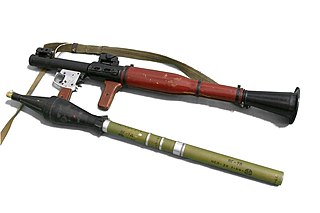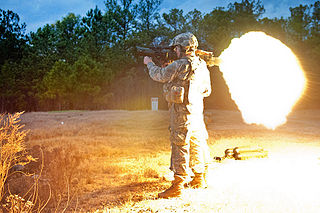
A rocket-propelled grenade is a shoulder-fired missile weapon that launches rockets equipped with an explosive warhead. Most RPGs can be carried by an individual soldier, and are frequently used as anti-tank weapons. These warheads are affixed to a rocket motor which propels the RPG towards the target and they are stabilized in flight with fins. Some types of RPG are reloadable with new rocket-propelled grenades, while others are single-use. RPGs are generally loaded from the front.

Armor-piercing ammunition is a type of projectile designed to penetrate either body armor or vehicle armor.

A flechettefleh-SHET is a pointed steel projectile with a vaned tail for stable flight. The name comes from French fléchette, "little arrow" or "dart", and sometimes retains the acute accent in English: fléchette. They have been used as ballistic weapons since World War I. Delivery systems and methods of launching flechettes vary, from a single shot, to thousands in a single explosive round. The use of flechettes as antipersonnel weapons has been controversial.

A recoilless rifle, recoilless launcher or recoilless gun, sometimes abbreviated "RR" or "RCL" is a type of lightweight artillery system or man-portable launcher that is designed to eject some form of countermass such as propellant gas from the rear of the weapon at the moment of firing, creating forward thrust that counteracts most of the weapon's recoil. This allows for the elimination of much of the heavy and bulky recoil-counteracting equipment of a conventional cannon as well as a thinner-walled barrel, and thus the launch of a relatively large projectile from a platform that would not be capable of handling the weight or recoil of a conventional gun of the same size. Technically, only devices that use spin-stabilized projectiles fired from a rifled barrel are recoilless rifles, while smoothbore variants are recoilless guns. This distinction is often lost, and both are often called recoilless rifles.

High-explosive anti-tank (HEAT) is a type of shaped charge explosive that uses the Munroe effect to penetrate heavy armor. The warhead functions by having an explosive charge collapse a metal liner inside the warhead into a high-velocity superplastic jet; this superplastic jet is capable of penetrating armor steel to a depth of seven or more times the diameter of the charge. The jet's effect is purely kinetic in nature; the round has no explosive effect on the target.

A shoulder-fired missile, shoulder-launched missile, man-portable rocket launcher, or man-portable missile is an explosive-carrying, self-propelled projectile fired at a target, while being small enough to be carried by a single person and fired while held on one's shoulder. The word "missile" in this context is used in its original broad sense which encompasses all guided missiles and unguided rockets. In many instances, although not technically defining all shoulder-fired missiles, the name bazooka is used as an informal name regularly, although the actual Bazooka is a type of shoulder-fired unguided rocket launcher in its own right.

An anti-tank rifle is an anti-materiel rifle designed to penetrate the armor of armored fighting vehicles, most commonly tanks, armored personnel carriers, and infantry fighting vehicles. The usefulness of rifles for this purpose ran from the introduction of tanks in World War I until the Korean War. While medium and heavy tank armor became too thick to be penetrated by rigid projectiles from rifles that could be carried by a single soldier, anti-tank rifles continued to be used against other "soft" targets, though recoilless rifles and rocket-propelled grenades such as the bazooka were also introduced for infantry close-layer defense against tanks.

Nexter Systems is a French government-owned weapons manufacturer, based in Roanne, Loire.

The M72 LAW is a portable one-shot 66-mm unguided anti-tank weapon. The solid rocket propulsion unit was developed in the newly formed Rohm and Haas research laboratory at Redstone Arsenal in 1959, then the full system was designed by Paul V. Choate, Charles B. Weeks, Frank A. Spinale, et al. at the Hesse-Eastern Division of Norris Thermadore. American production of the weapon began by Hesse-Eastern in 1963, and was terminated by 1983; currently it is produced by Nammo Raufoss AS in Norway and their subsidiary Nammo Talley, Inc. in Arizona.

The Panzerfaust 3 is a modern disposable recoilless anti-tank weapon, which was developed between 1978 and 1985 and put into service by the Bundeswehr in 1992. It was first ordered in 1973 to provide West German infantry with an effective weapon against contemporary Soviet armour, thereby replacing West Germany's aging PzF 44 Light Lanze launchers and the heavy Carl Gustaf 84 mm anti-tank recoilless rifle manufactured in Sweden. The Panzerfaust 3 is operated by at least 11 countries and has first seen combat in Afghanistan.

The RAC 112 APILAS, commonly designated APILAS, is a portable one-shot 112 mm recoilless anti-tank weapon, designed in France by GIAT Industries. Over 120,000 of the APILAS launchers have been produced, and they are in service with many countries.
The RPG-16 is a handheld anti-tank grenade launcher for anti-tank warfare. It was developed in 1968 and adopted by the Soviet Army in 1970 for special operation teams and the Soviet airborne troops (VDV). These were deployed during the Soviet–Afghan War in 1979-1989, and saw service in several battles in that theatre.

The Type 69 85mm rocket propelled grenade (RPG), made by Norinco, is a Chinese variant of the Soviet RPG-7. First introduced in 1972, the Type 69 is a common individual anti-tank weapon in service with the PLA. More advanced grenade rounds were developed in the 1980s and 1990s to meet the requirements of modern battlefields. Eventually, the aging Type 69 RPG family was replaced by modern anti-tank weapon systems developed by China such as Type 89 and Type 08.

The Type 98 (PF-98) is a 120mm unguided anti-tank rocket system developed by Norinco for the People's Liberation Army as a successor to the Type 65 and Type 78 recoilless guns. It is also known by its nickname, "Queen Bee".

The LRAC F1, officially called Lance-Roquettes AntiChar de 89 mm modèle F1 is a French reusable rocket launcher developed by Luchaire Défense SA, and manufactured in cooperation with Manufacture Nationale d'Armes de Saint-Étienne and was in the 1970s marketed by Hotchkiss-Brandt.

The M80 Zolja is a portable one-shot disposable 64 mm unguided anti-tank rocket-propelled grenade, designed in the former Yugoslavia. The M80 Zolja is still produced in Serbia and in North Macedonia.
RPG-76 Komar is a Polish light one-shot anti-tank grenade launcher that fires an unguided anti-tank rocket-propelled grenade. The weapon was designed as a smaller and lighter alternative to the RPG-7, especially for use by airborne troops. Thanks to jet nozzles located between the warhead and the fuel compartment, it can be fired from inside of a building or a vehicle.

The AC 58 is an anti-armour rifle grenade used by the French Army. Its official French Army designation is Grenade à fusil antichar de 58 mm Mle F1 PAB.
The AT4 is an 84-mm unguided, portable, single-shot recoilless smoothbore anti-tank weapon built in Sweden by Saab Bofors Dynamics. Saab has had considerable sales success with the AT4, making it one of the most common light anti-tank weapons in the world.
Man-portable anti-tank systems are shoulder-launched anti-tank rockets. They are typically unguided weapons and are a threat to armored vehicles, low-flying aircraft, and field fortifications. Generally, MANPATS fall into three distinct categories. The first consist of a small, disposable preloaded launch tube firing a high explosive anti-tank warhead operated by a single soldier. The second is a firing system onto/into which a rocket is loaded, operated by a single soldier. The third are manufactured prepacked and issued as a single unit of ammunition with the launcher discarded after a single use.















